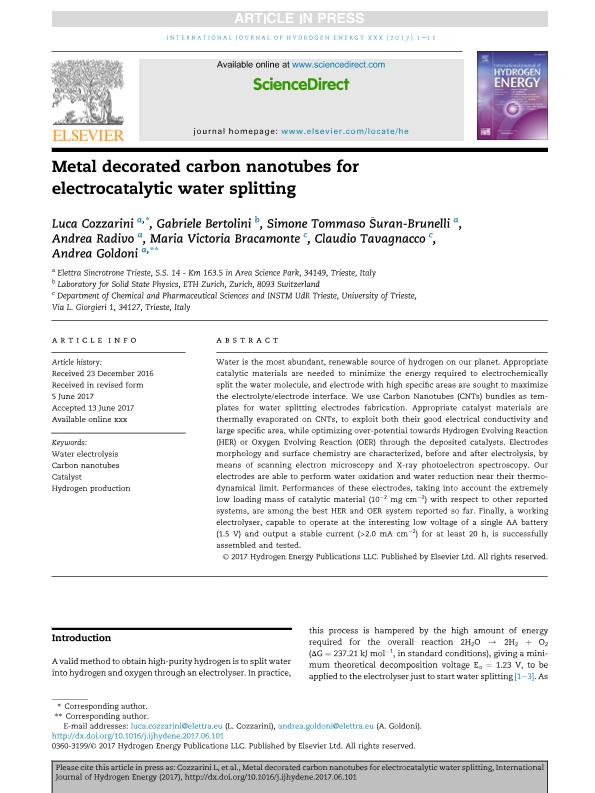Artículo
Metal decorated carbon nanotubes for electrocatalytic water splitting
Cozzarini, Luca; Bertolini, Gabriele; Suran Brunelli, Simone Tommaso; Radivo, Andrea; Bracamonte, Maria Victoria ; Tavagnacco, Claudio; Goldoni, Andrea
; Tavagnacco, Claudio; Goldoni, Andrea
 ; Tavagnacco, Claudio; Goldoni, Andrea
; Tavagnacco, Claudio; Goldoni, Andrea
Fecha de publicación:
27/07/2017
Editorial:
Pergamon-Elsevier Science Ltd
Revista:
International Journal of Hydrogen Energy
ISSN:
0360-3199
e-ISSN:
1097-458X
Idioma:
Inglés
Tipo de recurso:
Artículo publicado
Clasificación temática:
Resumen
Water is the most abundant, renewable source of hydrogen on our planet. Appropriate catalytic materials are needed to minimize the energy required to electrochemically split the water molecule, and electrode with high specific areas are sought to maximize the electrolyte/electrode interface. We use Carbon Nanotubes (CNTs) bundles as templates for water splitting electrodes fabrication. Appropriate catalyst materials are thermally evaporated on CNTs, to exploit both their good electrical conductivity and large specific area, while optimizing over-potential towards Hydrogen Evolving Reaction (HER) or Oxygen Evolving Reaction (OER) through the deposited catalysts. Electrodes morphology and surface chemistry are characterized, before and after electrolysis, by means of scanning electron microscopy and X-ray photoelectron spectroscopy. Our electrodes are able to perform water oxidation and water reduction near their thermo-dynamical limit. Performances of these electrodes, taking into account the extremely low loading mass of catalytic material (10−2 mg cm−2) with respect to other reported systems, are among the best HER and OER system reported so far. Finally, a working electrolyser, capable to operate at the interesting low voltage of a single AA battery (1.5 V) and output a stable current (>2.0 mA cm−2) for at least 20 h, is successfully assembled and tested.
Palabras clave:
Carbon Nanotubes
,
Catalyst
,
Hydrogen Production
,
Water Electrolysis
Archivos asociados
Licencia
Identificadores
Colecciones
Articulos(IFEG)
Articulos de INST.DE FISICA ENRIQUE GAVIOLA
Articulos de INST.DE FISICA ENRIQUE GAVIOLA
Citación
Cozzarini, Luca; Bertolini, Gabriele; Suran Brunelli, Simone Tommaso; Radivo, Andrea; Bracamonte, Maria Victoria; et al.; Metal decorated carbon nanotubes for electrocatalytic water splitting; Pergamon-Elsevier Science Ltd; International Journal of Hydrogen Energy; 42; 30; 27-7-2017; 18763-18773
Compartir
Altmétricas



